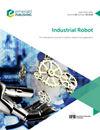改进的A*算法和基于模型预测控制的六足机器人路径规划与跟踪框架
IF 2.5
4区 计算机科学
Q3 ENGINEERING, INDUSTRIAL
Industrial Robot-The International Journal of Robotics Research and Application
Pub Date : 2022-08-04
DOI:10.1108/ir-01-2022-0028
引用次数: 1
摘要
路径规划是机器人研究中的一个基础和重要问题,特别是对于有腿机器人来说,路径规划是机器人完成自主导航、自主探索等复杂任务的核心技术。本文的目的是提出一种六足机器人自主导航的路径规划和跟踪框架。首先,简要介绍了一种名为hexapod - mini的六足机器人。然后提出了一种基于改进a *的路径规划算法,该算法将人工势场(artificial potential field, APF)因子引入到评估函数中,生成安全无碰撞的初始路径;然后应用基于贪心算法的拐点优化,优化路径的匝数。提出了一种六足机器人的快速转弯轨迹,并将其应用于路径平滑。此外,采用基于模型预测控制的运动跟踪控制器进行路径跟踪。仿真和实验结果表明,该框架能够生成安全、快速、无碰撞、平滑的路径,笔者设计的六足机器人能够有效地跟踪该路径,验证了该框架的性能。提出了一种六足机器人自主路径规划和跟踪的框架。该方法克服了传统路径规划方法缺乏安全性、平滑性不足、转弯数过多等缺点。该方法已成功应用于实际的六足机器人。本文章由计算机程序翻译,如有差异,请以英文原文为准。
Improved A* algorithm and model predictive control- based path planning and tracking framework for hexapod robots
Purpose
Path planning is a fundamental and significant issue in robotics research, especially for the legged robots, since it is the core technology for robots to complete complex tasks such as autonomous navigation and exploration. The purpose of this paper is to propose a path planning and tracking framework for the autonomous navigation of hexapod robots.
Design/methodology/approach
First, a hexapod robot called Hexapod-Mini is briefly introduced. Then a path planning algorithm based on improved A* is proposed, which introduces the artificial potential field (APF) factor into the evaluation function to generate a safe and collision-free initial path. Then we apply a turning point optimization based on the greedy algorithm, which optimizes the number of turns of the path. And a fast-turning trajectory for hexapod robot is proposed, which is applied to path smoothing. Besides, a model predictive control-based motion tracking controller is used for path tracking.
Findings
The simulation and experiment results show that the framework can generate a safe, fast, collision-free and smooth path, and the author’s Hexapod robot can effectively track the path that demonstrates the performance of the framework.
Originality/value
The work presented a framework for autonomous path planning and tracking of hexapod robots. This new approach overcomes the disadvantages of the traditional path planning approach, such as lack of security, insufficient smoothness and an excessive number of turns. And the proposed method has been successfully applied to an actual hexapod robot.
求助全文
通过发布文献求助,成功后即可免费获取论文全文。
去求助
来源期刊
CiteScore
4.50
自引率
16.70%
发文量
86
审稿时长
5.7 months
期刊介绍:
Industrial Robot publishes peer reviewed research articles, technology reviews and specially commissioned case studies. Each issue includes high quality content covering all aspects of robotic technology, and reflecting the most interesting and strategically important research and development activities from around the world.
The journal’s policy of not publishing work that has only been tested in simulation means that only the very best and most practical research articles are included. This ensures that the material that is published has real relevance and value for commercial manufacturing and research organizations. Industrial Robot''s coverage includes, but is not restricted to:
Automatic assembly
Flexible manufacturing
Programming optimisation
Simulation and offline programming
Service robots
Autonomous robots
Swarm intelligence
Humanoid robots
Prosthetics and exoskeletons
Machine intelligence
Military robots
Underwater and aerial robots
Cooperative robots
Flexible grippers and tactile sensing
Robot vision
Teleoperation
Mobile robots
Search and rescue robots
Robot welding
Collision avoidance
Robotic machining
Surgical robots
Call for Papers 2020
AI for Autonomous Unmanned Systems
Agricultural Robot
Brain-Computer Interfaces for Human-Robot Interaction
Cooperative Robots
Robots for Environmental Monitoring
Rehabilitation Robots
Wearable Robotics/Exoskeletons.

 求助内容:
求助内容: 应助结果提醒方式:
应助结果提醒方式:


